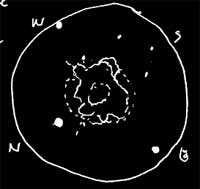

Observation Notes:
This was a large, bright globular. It was hard to find at first, due to its nearness to a number of bright stars. So it didn’t stand out so well in the finder. 38X showed a hint of granularity. The southern side of the cluster seemed to cut off more sharply in both the 38X and 120X view. Overall its shape was mainly circular, but rays seemed to project north-northeast and north-northwest. A lot more granularity and outlying stars were visible at 120X. Barlowing to 240X showed the core to reside at the north end of the cluster with a slight gap of stars to the south of the core, which may account for the sharper light dropoff on the south end.
Factoids:
M15 is among the more obvious globular clusters. It lies about 33,600 light years away and is about 175 light years in diameter. It is approaching us at 107 km/sec. It is possibly the densest of the Milky Way globular clusters. It has undergone a core collapse and half of the mass of the cluster resides within a 10 light year radius. It was discovered in 1746 by Jean-Dominique Maraldi and cataloged by Charles Messier in 1764.
| Subject | M15 (NGC 7078) | |
| Classification | Globular Cluster (Class IV) | |
| Position* | Pegasus [RA: 21:30:00 / Dec: +12:10:00] | |
| Size* | 18.0′ | |
| Brightness* | 6.2 | |
| Date/Time | October 9, 2004 – 12:15 PM (October 9, 2004 – 07:15 UT) |
|
| Observing Loc. | Flagstaff, AZ – Home | |
| Instrument | Orion SVP 6LT Reflector (150 mm dia./1200 mm F/L) | |
| Eyepieces/Mag. | 32 mm (48X), 10 mm (120X), 10 mm + 2X (240X) | |
| Conditions | Unrecorded | |
| Seeing | 4/10 | |
| Transparency | Mag 5.5 NELM | |
| Sources | SEDS |
*Based on published data.